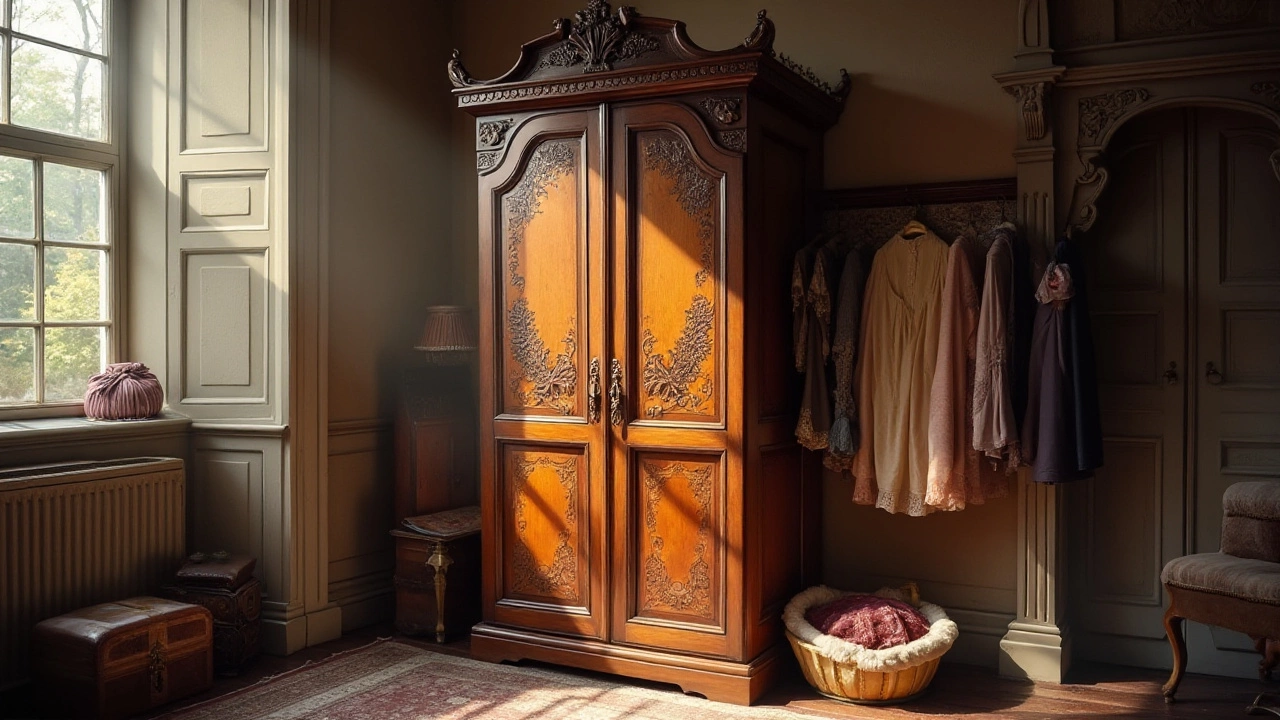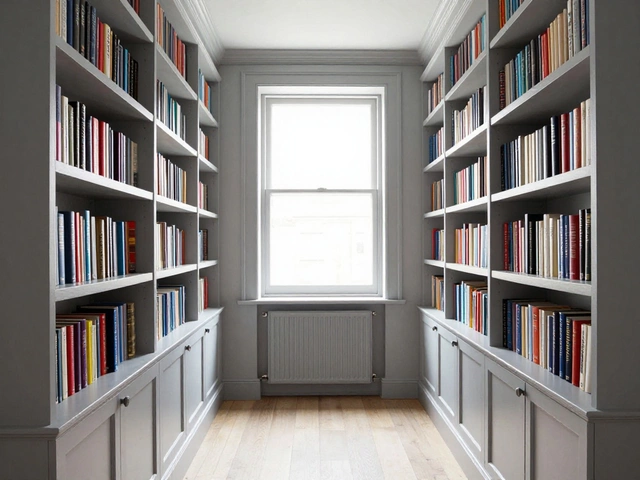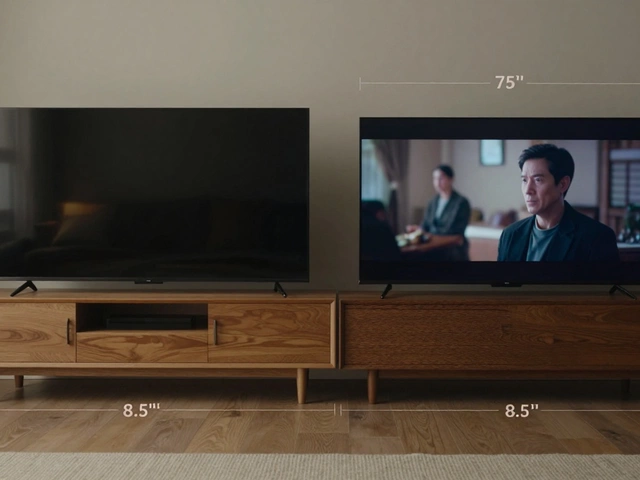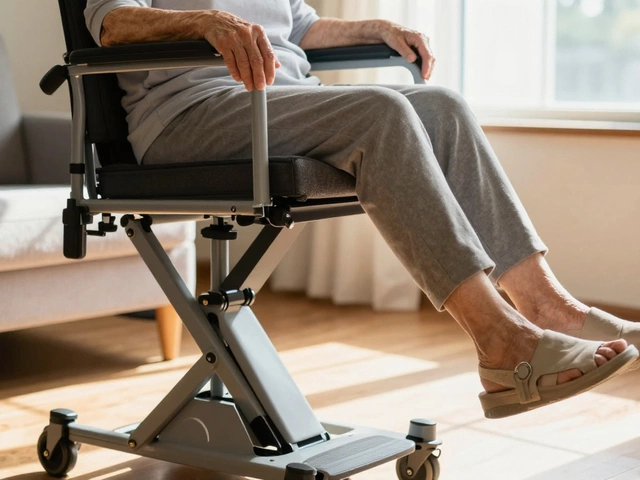When we think of a wardrobe, what often comes to mind is a mere piece of furniture where we keep our clothes. However, a wardrobe is so much more than just a box with doors. It's a reflection of your style and an essential part of maintaining order in your living space.
From historical methods of storing clothes to modern design marvels, wardrobes have evolved remarkably over the years. Understanding the different types of wardrobes and what they offer can transform how you organize and present your attire. Whether it's a minimalist wardrobe or a classic armoire, each has its own charm and utility.
This article is here to walk you through the nuances of wardrobes, helping you make informed choices that enhance both your lifestyle and living environment.
- The Historical Context of Wardrobes
- Types of Wardrobes and Their Uses
- Wardrobe as a Style Statement
- Choosing the Right Wardrobe for Your Space
- Maintaining and Organizing Your Wardrobe
The Historical Context of Wardrobes
The journey of the wardrobe begins long before closets became a staple in architectural design. Its roots trace back to medieval England, when a wardrobe referred not to a piece of furniture, but rather an entire room dedicated to storing the robes of the royal family. This concept of specialized storage has continuously evolved, reflecting broader cultural shifts and advancements in technology. Initially, wardrobes were exclusively for the affluent, symbolizing status and wealth. The craftsmanship involved in these furnishings was as important as the garments they held, with intricate carvings and exquisite woodwork that proudly displayed the owner's social standing.
It wasn't until the Renaissance period, as homes of the wealthy grew larger and more elaborate, that wardrobes began to transition into free-standing pieces of furniture, resembling the cabinets we recognize today. During this era, clothing styles became more complex and varied, necessitating improved methods for storage and retrieval. As society advanced into the Industrial Revolution, wardrobes became more widespread and accessible to the emerging middle class. The production processes changed, allowing for mass production which, in turn, made wardrobes more affordable and customizable.
Around the 19th century, the development of the modern wardrobe exploded, as the design transformed into what we commonly see—compartments and hanging space for clothing. By the 20th century, especially after the World War periods, urbanization and apartment living spearheaded the compact and efficient use of space. This is when wardrobes truly found their place in everyday homes. Interestingly, in a statement by renowned historian Liza Picard, she remarked, "The evolution of the wardrobe mirrors the journey of human vanity and utility, moving from opulence to necessity."
By examining historical data, we can see how certain wardrobe designs thrived in different cultures. In Japan, for instance, tansu cabinets were popular, showcasing a minimalist style that emphasized functionality. Each of these variations reflects not only functional needs but also cultural identity—a testament to the importance of wardrobes beyond their utilitarian purpose. The adaptation of various styles from around the globe enabled wardrobes to become versatile, leading to modern adaptations that offer solutions for diverse tastes and needs. Whether carved in oak or fashioned in steel, wardrobes remain an essential, personal space for individuals worldwide.
Types of Wardrobes and Their Uses
Awardrobes are far from monolithic; they vary in design, size, and functionality, each catering to different needs and aesthetics. The classic freestanding wardrobe, for example, is a staple in many homes due to its versatility and ease of placement. This type can often be moved and repositioned easily, allowing homeowners to experiment with room layouts. Freestanding wardrobes also come in various styles, from vintage to modern, offering a great deal of customization in terms of appearance and interior layout.
Built-in wardrobes, on the other hand, are designed to integrate seamlessly into the architecture of a room. These are often favored in homes where maximizing space is crucial, as they can be tailored to fit snugly into corners and nooks. Built-ins offer the added benefit of boosting home resale value, given their elegant and permanent nature. Walk-in wardrobes represent another category, providing luxury and abundant space for those fortunate enough to accommodate them. A well-designed walk-in can serve as a dressing room and storage haven brimming with potential for personalization with mirrors, seating, and vanity units.
"A wardrobe is an essential frame of reference for the dress of the day," said home design expert, Andrea Foster, emphasizing its importance in daily life and personal style.
Wardrobes can also be categorized by their door mechanisms. Sliding door wardrobes are excellent for rooms with limited space, as they don't require additional clearance to open. Meanwhile, hinged door wardrobes are traditional and often preferred for their wide-opening capability, allowing a full view of the contents at once. For those who appreciate a touch of innovation, integrated lighting and smart storage solutions are increasingly common, catering to a modern audience that values both style and efficiency in their clothing storage.
Materials significantly influence the function and aesthetic of a wardrobe. Solid wood wardrobes provide durability and a classic look, though they can be quite heavy and expensive. In contrast, wardrobes made from medium-density fiberboard (MDF) or particleboard are budget-friendly and lightweight, though they might not withstand wear and tear as well as their solid wood counterparts. Metal wardrobes, though less common in homes, are renowned for their robustness and are a frequent choice in industrial or minimalist style settings. The decision between these materials depends largely on personal preference, budget, and the overall theme of the room.
Choosing the right wardrobe means considering your specific needs and how you interact with your clothing on a daily basis. Do you have a lot of long dresses or suits that require hanging space? Or perhaps you need ample shelving for folded garments? Closet design doesn't just stop at the wardrobe style—it extends to the interior. The right mix of hanging rods, shelves, drawers, and organizers can transform even the most basic wardrobe into a functional masterpiece that serves all your storage needs without compromising on style.
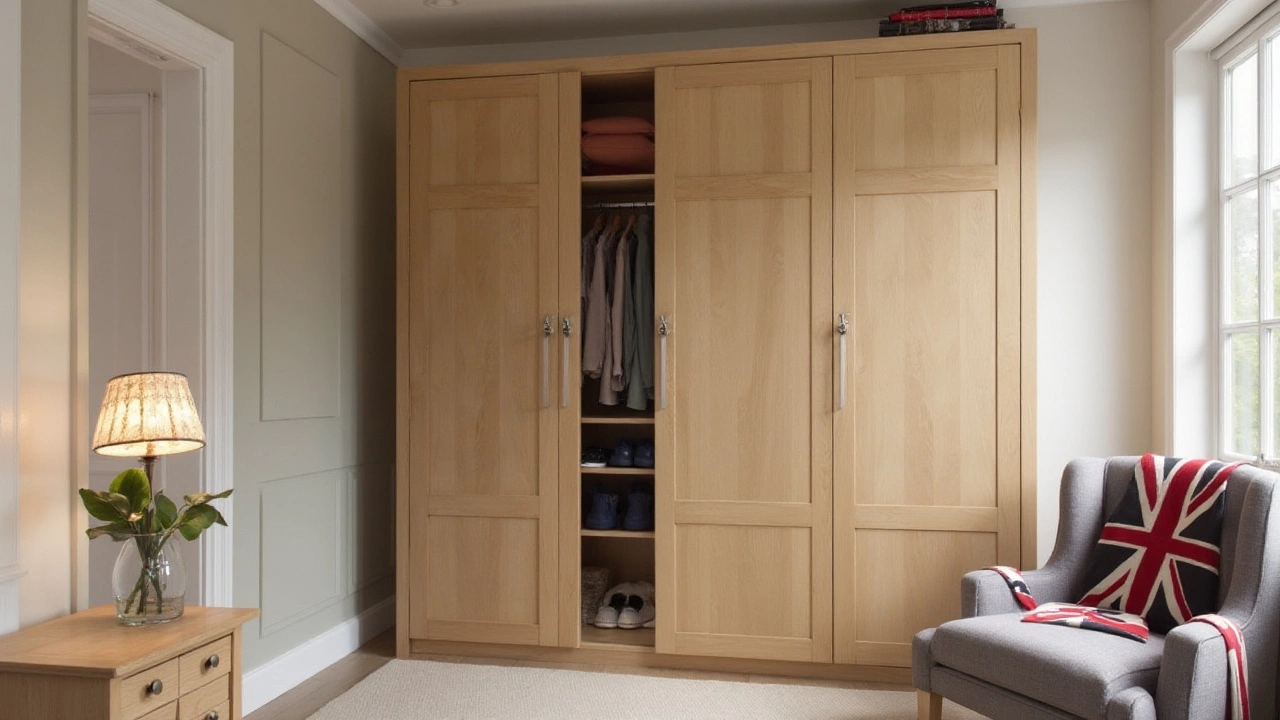
Wardrobe as a Style Statement
The wardrobe is more than just a practical element of furniture; it's an extension of your personal style. Much like the clothes it houses, a wardrobe can make a statement about who you are and how you live your life. Wardrobes have become increasingly sophisticated, serving not only as utilitarian storage solutions but as focal points of bedroom design. In many homes, they are no longer tucked away but featured prominently, complementing or even driving the room's design elements. From minimalist to ornate, the style of your wardrobe can significantly impact the ambiance of the room it resides in.
A fine example is the integrated wardrobe design. These seamlessly blend into the room and create a sleek, minimalist look. Such wardrobes, often devoid of protruding handles or excessive ornamentation, suggest a modern and uncluttered lifestyle. On the other hand, vintage-inspired armoires, with their intricate woodwork and pronounced presence, narrate a love for history and craftsmanship. Many homeowners are opting for bespoke wardrobes, tailored specifically to their tastes, needs, and the dimensions of their living space. This customization speaks volumes about their approach to personal, organized living.
Material and Finish Choices
The choice of material and finish also plays a crucial role in the wardrobe's statement. Materials like walnut or mahogany offer a rich, traditional finish, whereas high-gloss laminated finishes bring out a contemporary feel. Mirrored doors not only add a touch of elegance but serve a dual purpose by making rooms look larger and more open. Closet design has evolved to incorporate a variety of these materials, allowing homeowners to find the perfect balance between aesthetics and functionality. For those who wish to steer clear of mass-produced furniture, reclaimed wood wardrobes have become a popular option. They tell a story of sustainability and uniqueness, attracting those who value eco-friendly living without compromising on style.
"Simplicity is the ultimate sophistication." - Leonardo da Vinci, though often attributed in broader context, this quote resonates with minimalist wardrobe designs that focus on refined simplicity.
Beyond the visual attributes, your wardrobe's interior layout also communicates your sensibilities. A well-organized interior with partitioned compartments, dedicated shelves, and built-in drawers reflects a penchant for order and efficiency. Some wardrobes incorporate hidden features like pull-out ironing boards or shoe racks, making them not only stylish but pragmatic.
Wardrobes in Interior Trends
Interior design trends frequently influence wardrobe styles. Many modern designs are turning towards open wardrobes, which blend seamlessly with open-plan living concepts. These setups invite a curated display of clothing and accessories, rather reminiscent of high-end boutique formats, where each piece is given space to breathe and be admired. In contrast, sliding door wardrobes cater to urban apartments with space constraints, offering style without sacrificing valuable floor area. The wardrobe is not just a container for clothing; it is a crucial part of your home environment. Its style, materials, and interior design reveal and enhance who you are. Whether traditional or trendy, a wardrobe's presentation and organization can beautifully highlight your lifestyle in every way.
Choosing the Right Wardrobe for Your Space
Selecting the ideal wardrobe for your home is much like tailoring a suit; it requires a keen eye for detail and a clear understanding of your personal style and space constraints. While the choice largely hinges on individual needs, a few universal considerations can guide the process. Assessing the dimensions of the space where the wardrobe will be placed is the primary step. Measure the height, width, and depth available, factoring in the clearance space needed to comfortably open the wardrobe doors. This avoids the common pitfall of buying furniture that's either too large or awkwardly small for its intended spot.
Material is another critical factor when choosing a clothing storage solution. Wood remains a classic choice for wardrobes due to its durability and timeless aesthetic. For those who lean towards eco-friendly options, consider wardrobes made from reclaimed wood or sustainable materials like bamboo. Metal and composite materials offer a sleek modern look and are often lighter, making them easier to move. A study from the International Furniture Design Association noted that 65% of modern households prefer a blend of different materials in their furniture for both practical and stylistic reasons.
The interior layout of the wardrobe should also meet your specific storage needs. Think about the types of clothing and accessories you need to store. If your wardrobe consists mainly of suits and dresses, ensure the wardrobe has ample hanging space. For those with an extensive shoe collection, built-in shoe racks are a non-negotiable feature. Despite these common needs, customization remains key; many wardrobes now come with adjustable shelves and additional accessories like built-in mirrors and lighting, allowing for a personal touch and increased functionality.
According to Jane Smith, a renowned interior designer, "A wardrobe is not just a storage solution; it's a part of the room's identity. Choosing the right style and finish can dramatically transform the look and feel of a space." This sentiment reflects the importance of aesthetic consideration in your selection. The wardrobe should complement the existing decor, whether by matching hues and textures or adding a contrasting but cohesive element to the room's design scheme.Accessibility also plays a vital role when picking the perfect home organization unit. Consider sliding doors for narrow rooms where swinging doors might obstruct movement. For tech-savvy homeowners, there are options with smart features such as automated doors, built-in chargers, and connectivity with home systems. Such advanced wardrobes can integrate seamlessly into a smart home ecosystem, offering both convenience and a touch of luxury.
Ultimately, creating a blend of style, functionality, and fit should be the goal in selecting the perfect wardrobe. Spending time in this decision-making process and investing in quality can lead to a storage solution that best reflects and enhances personal lifestyle. It's not just about storage space; it’s about making a statement and crafting an environment that feels just right.
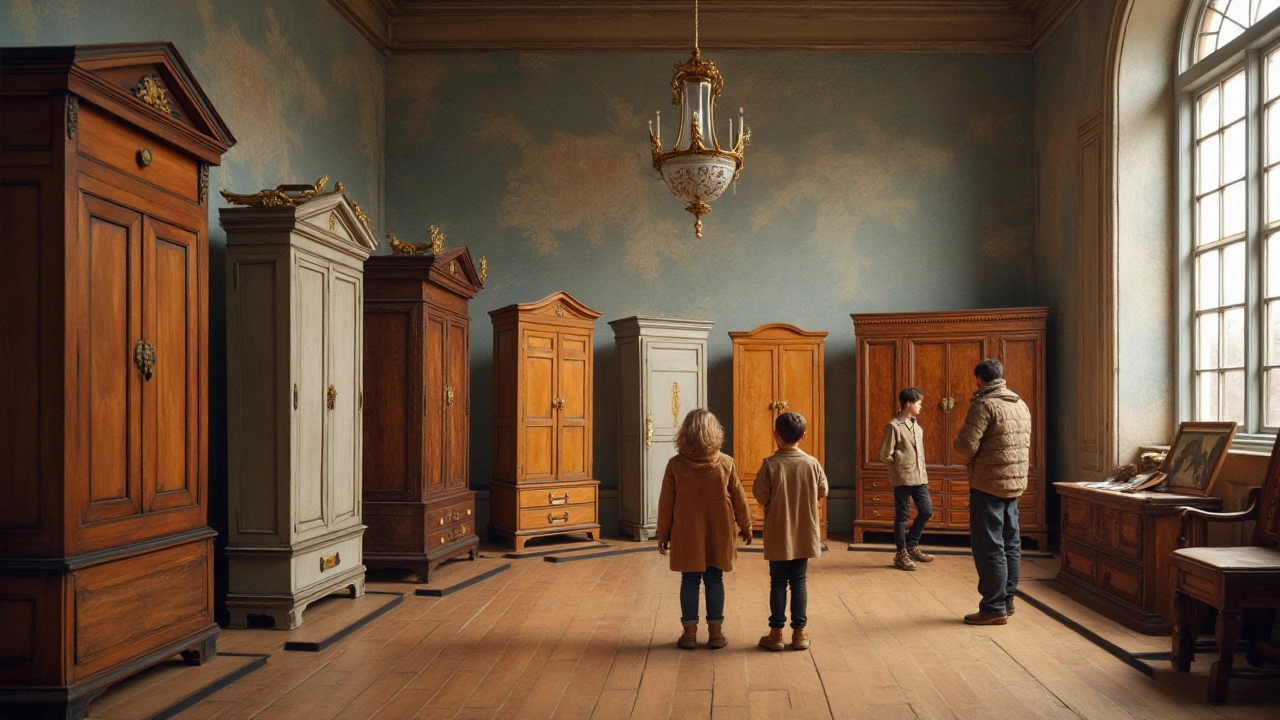
Maintaining and Organizing Your Wardrobe
A well-kept wardrobe is not only a symbol of a neat living space but also a sanctuary for your cherished garments. Regular maintenance and thoughtful organization can extend the life of your clothing storage and ensure easy access to your favorite outfits. First and foremost, give each piece of clothing the space it deserves. Overcrowding can lead to wrinkles and make it hard to find what you're looking for when you need it. Consider the frequency of use—place your most-used items in easily reachable spots to save time and hassle during busy mornings. It's also important to revisit your wardrobe with each changing season. Rotate clothes accordingly to keep the current season's attire at eye level and within reach.
Cleaning the interior and exterior of your wardrobe should be part of your routine upkeep. Dust and moisture can settle on surfaces, leading to an invitation for moths and other pests that have a special affinity for wardrobes. Use a soft cloth dipped in a gentle cleaning solution to wipe down surfaces regularly. Installing cedar blocks is also a fragrant way to deter moth infestations. They naturally repel unwanted critters and keep your clothing smelling fresh. Breaking down organization further, consider using dividers or storage boxes within the wardrobe to separate different types of clothing, like accessories, undergarments, and seasonal items. Clearly labeled bins can provide a quick visual cue, making it easier for you to categorize and retrieve specific items.
A clever storage system doesn't just end with how clothes are displayed. Accessories need special attention, too. Use hooks or rods to hang ties, belts, and scarves, taking advantage of vertical spaces often left unused. This makes accessories more visible and accessible, ensuring you do not forget that statement piece that completes your outfit. For shoes, consider investing in tiered shelves or storage boxes that can be stacked. Group shoes by category, such as casual, formal, or sports, to streamline your choices. A tidy shoe setup can mean the difference between a rushed, frantic morning and a calm, collected start to your day.
A planned color scheme can add an aesthetic edge to your wardrobe while aiding organization. Arrange clothes in a gradient from dark to light or by color blocks, which not only looks pleasing to the eye but also allows for quick decision-making when constructing outfits. Introducing technology into your wardrobe system can be another game-changer. Some modern wardrobes come equipped with LED lights that illuminate fabrics, making it easier to differentiate shades and textures in dim lighting. Smart wardrobes can even track what clothes you wear frequently and suggest outfit combinations based on weather and mood.
"Your wardrobe is a personal treasure chest, filled with stories and memories. Tending to it with care will not only make dressing more joyful but also extend the life of your garments," says the renowned fashion consultant, Linda Hallberg.In the spirit of Marie Kondo's famous tidying philosophy, practice gratitude by regularly assessing which items inspire joy and repurposing or donating those that do not. This approach keeps your wardrobe from becoming a graveyard for unused attire and fosters a more meaningful relationship with your belongings. Finally, jotting down a wardrobe inventory can help manage what you have, preventing unnecessary purchases and saving your budget for more intentional investments. Remarkably, recent studies show that people wear only about 20% of their wardrobe 80% of the time, emphasizing the need for regular review and thoughtful organization.

